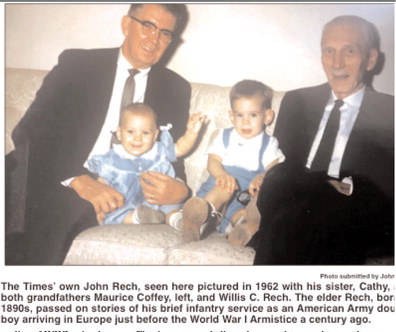My World War One Story…

Remembering those who served and paid the ultimate price this Memorial Day
news@theeveningtimes.com
Because it was so horrific, it became known as “the war to end all wars.”
World War I delivered new technological innovations to warfare.
Airplanes, tanks, poisonous gas and trench warfare repulsed people so much that many envisioned the dawn of a world-wide perpetual peaceful utopian era.
In 2018, the eleventh hour, of the eleventh day, of the eleventh month marked the centennial anniversary of the end of “The Great War.” It seems such a long time ago, but this 60-year-old writer has three connections to the Great War.
My grandfather Willis C.
Rech served in the
Continued on Page 2 WORLD WAR ONE (cont.)
infantry as a doughboy. He died when I was 19, but not before telling me his WWI story, such that it was. He mused about basic training when he learned marching with a broomstick. The drill sergeant became frustrated that many of the recruits were illiterate farmers who did not know their right hand from their left. So, he ordered bales of hay and straw. Straw was put in the left boot of each soldier and hay in the right.
Every selfrespecting farm boy knows the difference between hay and straw said grandpa.
Then off marching they'd go, the sergeant barking alternate commands — hay foot, straw foot. He was shipped to Europe.
Grandpa arrived in France in November 1918, one hundred years ago this month, just in time to enjoy Paris and the Armistice. He never saw combat. So, I was contemporary to one veteran from that long-ago war.
I grew up in Denver, the American hometown of the famous Richthofen family.
In pursuit of utopian wellness, the Red Barron's uncle built a huge castle replicating the family castle in Germany in the Montclair neighborhood of the Mile-High City. The crisp and thin high-altitude air, pure spring water, and fourseason climate were thought to deliver health and healing. The huge stone castle in an idyllic setting captured my imagination and served to romanticize for me what was in reality one of humankind's worst events, WWI.
The Richthofen Castle was built by Baron Walter von Richthofen, the godfather of the 'Red Baron.' Richthofen Castle was begun in 1883 and completed in 1887, and modeled on the original Richthofen Castle in Germany. The last realestate asking price for the mansion was $4,000,000.
Baron von Richthofen promoted the place as 'a fount of health and prosperity, and as a model community with enlightened planning and sophisticated architecture.”
My infatuation of the war began at the locked front gate. There I could see sitting in the front yard a fullscale version of the WWI flying Ace, Baron von Richthofen's, Fokker DR-1 Tri-plane, painted in German Red complete with Iron Cross markings.
Whenever I watched the Peanuts cartoon character Snoopy throw his scarf around his neck and fly his dog house Sopwith Camel into a dog fight, I'd daydream about fighting in the sky, maneuvering against the Red Baron.
I spent most of my childhood convinced the oldworld castle in town was inhabited by vampires.
Though the place was never open to the public that I knew, the basement was reputed to have the Red Baron Pub — a complete replica of a WWI pub with mannequin soldiers and nurses in real uniforms. All that fantasy was much removed from the horrible reality of WWI gained another life connection. In addition to growing up in Denver, as an adult I resided for a while in St.
Marys, (yes with no apostrophe), Kansas before moving to Marion. Those cities shared a WWI connection.
Lieutenant William T.
Fitzsimons (1889-1917), an American officer in the Medical Reserve Corps, was the first United States Army officer killed in action in World War I. The Doctor matriculated at St.
Marys College and later became a University of Kansas alumnus and faculty member. He died from wounds suffered during a German air raid on September 4, 1917, when bombs fell on Base Hospital No. 5 near Dannes-Camiers in Pas-de-Calais, France. Following his death, a memorial to Fitzsimons was dedicated in Kansas City which became the National WWI Museum.
I toured the National museum in Kansas City across from the Union Train Station four years ago. It was a poignant, sobering experience to walk over the glass floor above the poppies of Flanders's Field, and to see the trench warfare displays and hear the sounds of battle. The museum experience was a complete contrast to my childhood play with Snoopy and the castle. I finally found The Fitzsimons exhibit, a reminder to the randomness of death, especially on the battlefield.
The old Army Hospital #21


